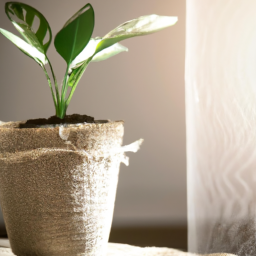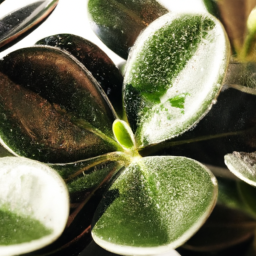
Are you looking for a natural and effective way to purify the air in your home or office? Look no further than indoor plants! You may be surprised to learn that these green companions do more than just add beauty to your space – they also have the power to cleanse the air we breathe. In this blog post, we will explore the question, “How do indoor plants help purify the air?” We will delve into the fascinating world of indoor plants and their ability to remove harmful toxins and pollutants from our indoor environments. So, if you are curious about the science behind this green phenomenon and want to create a healthier living or working space, keep reading to discover the incredible benefits of indoor plants.
The Benefits of Indoor Plants for Air Purification
Indoor plants not only add beauty and vibrancy to our living spaces, but they also play a crucial role in purifying the air we breathe. With the increase in indoor pollution caused by various factors such as chemicals, dust, and volatile organic compounds (VOCs), having indoor plants can significantly improve the air quality and enhance our overall well-being. In this article, we will explore the numerous benefits of indoor plants for air purification and provide you with a step-by-step guide on how they work their magic.
How Indoor Plants Purify the Air
Indoor plants have the remarkable ability to remove harmful pollutants from the air through a process called phytoremediation. They absorb these pollutants through their leaves and roots, breaking them down into harmless byproducts or storing them within their tissues. This natural air purification process not only helps to remove toxins but also increases humidity levels, reduces dust, and minimizes the risk of respiratory issues.
1. Removing Harmful Chemicals: Indoor air can contain a variety of harmful chemicals, such as formaldehyde, benzene, and trichloroethylene, which are commonly found in household products and building materials. Plants like the Peace Lily, Snake Plant, and Spider Plant are known for their ability to absorb and neutralize these chemicals, making the air cleaner and safer to breathe.
2. Filtering Volatile Organic Compounds (VOCs): VOCs are organic chemicals that easily evaporate into the air and can have adverse effects on our health. They are commonly found in cleaning products, paints, and synthetic materials. Plants like the Boston Fern, English Ivy, and Aloe Vera are excellent at filtering VOCs, reducing their concentration in the indoor environment and improving air quality.
3. Increasing Humidity: Dry indoor air can cause various respiratory problems and discomfort. Indoor plants release moisture through a process called transpiration, which increases humidity levels in the surrounding air. Plants such as Areca Palm, Rubber Plant, and Boston Fern are particularly effective at humidifying indoor spaces, creating a more comfortable and healthier environment.
Choosing the Right Indoor Plants
When it comes to selecting indoor plants for air purification, it’s essential to consider their specific air-cleansing abilities, maintenance requirements, and suitability for your living space. Here are a few popular indoor plants known for their air-purifying qualities:
1. Snake Plant (Sansevieria Trifasciata): Also known as the “Mother-in-Law’s Tongue,” this plant is highly effective in filtering out formaldehyde, benzene, and trichloroethylene. It is low-maintenance and can thrive in low light conditions, making it ideal for beginners.
2. Peace Lily (Spathiphyllum): The Peace Lily is known for its ability to remove common household pollutants like formaldehyde, benzene, and ammonia. It also adds a touch of elegance with its beautiful white flowers. Keep in mind that this plant prefers moderate to low light and regular watering.
3. Spider Plant (Chlorophytum Comosum): Spider Plants are excellent at filtering formaldehyde and xylene from the air, making them a popular choice for indoor air purification. They are easy to care for and can thrive in various lighting conditions.
Maintaining Indoor Plants for Air Purification
To ensure that your indoor plants continue to purify the air effectively, proper care and maintenance are essential. Here are some tips to keep in mind:
1. Provide Adequate Light: Most indoor plants require bright, indirect light to thrive. Place them near windows or provide artificial lighting if natural light is limited in your space.
2. Water Regularly: Each plant has different watering needs, so it’s crucial to understand the requirements of your specific plants. Overwatering or underwatering can be detrimental to their health.
3. Monitor Humidity Levels: While indoor plants can naturally increase humidity, it’s important to ensure that the levels don’t become excessively high, as this can lead to mold growth. Use a hygrometer to keep track of humidity levels.
4. Clean the Leaves: Dust and debris can accumulate on the leaves of indoor plants, hindering their ability to purify the air effectively. Wipe the leaves gently with a damp cloth to remove any buildup.
5. Rotate Plants: Rotating your plants every few weeks allows all sides to receive adequate light and prevents them from leaning towards a light source, ensuring even growth.
By following these simple steps, you can enjoy the numerous benefits of indoor plants for air purification while creating a healthier and more inviting indoor environment.

Understanding the Mechanisms Behind Indoor Plants’ Air Purifying Abilities
Indoor plants not only enhance the aesthetic appeal of our living spaces but also play a vital role in purifying the air we breathe. These green companions have the remarkable ability to remove harmful toxins and pollutants from the indoor environment. In this article, we will delve into the mechanisms behind indoor plants’ air purifying abilities and how they can improve the quality of the air we breathe.
The Power of Photosynthesis
Photosynthesis, the process by which plants convert sunlight into energy, is the key mechanism that enables indoor plants to purify the air. During photosynthesis, plants absorb carbon dioxide (CO2) from the air and release oxygen. This natural process helps to increase the oxygen levels in our indoor spaces, making the air fresher and healthier to breathe.
Moreover, photosynthesis also plays a crucial role in removing volatile organic compounds (VOCs) from the air. VOCs are harmful chemicals released by various household products, such as cleaning agents, paints, and furniture. These chemicals can have adverse effects on our health, including respiratory issues and allergies. However, indoor plants absorb VOCs through their leaves and roots, effectively reducing their concentration in the air.
It is important to note that different plants have varying photosynthetic capacities. Plants with larger leaves and more chlorophyll, such as peace lilies and snake plants, are particularly efficient at purifying the air. By strategically placing these plants in our living spaces, we can maximize their air purifying benefits.
The Role of Microorganisms
While photosynthesis is the primary mechanism behind indoor plants’ air purifying abilities, microorganisms present in the soil also contribute significantly to this process. The soil acts as a natural filter, hosting a diverse community of microorganisms, including bacteria and fungi.
These microorganisms play a crucial role in breaking down and neutralizing harmful pollutants present in the air and soil. They convert these pollutants into less harmful substances, effectively reducing their concentration in the indoor environment. Furthermore, the microorganisms in the soil also help to maintain a healthy balance of nutrients, ensuring optimal plant growth and air purification.
It is worth mentioning that proper care and maintenance of indoor plants are essential to support the growth of these beneficial microorganisms. Regular watering, appropriate fertilization, and adequate sunlight are necessary to create a favorable environment for the microorganisms to thrive and contribute to the air purification process.
The Importance of Transpiration
Transpiration, the process by which plants release water vapor through their leaves, also plays a significant role in purifying the air. As plants transpire, they release moisture into the surrounding environment, increasing the humidity levels. This increased humidity helps to reduce the concentration of airborne pollutants, such as dust particles and allergens.
Moreover, the moisture released during transpiration also acts as a natural air purifier by trapping and removing airborne particles. These particles, including bacteria, mold spores, and other allergens, adhere to the water droplets released by the plants and eventually settle, effectively removing them from the air we breathe.
In addition to improving air quality, the increased humidity resulting from transpiration can also have positive effects on our overall well-being. It helps to alleviate dry skin, reduce respiratory irritations, and even improve our mood and cognitive function.
By understanding the mechanisms behind indoor plants’ air purifying abilities, we can fully appreciate the benefits they bring to our indoor environments. From photosynthesis to the role of microorganisms and transpiration, these natural processes work together to create cleaner, fresher, and healthier air for us to breathe. So, why not invite some green companions into your living spaces and enjoy the numerous benefits they provide?

Best Indoor Plants for Improving Air Quality
Introduction
Indoor plants not only add beauty to our living spaces but also play a vital role in improving the air quality of our homes. They act as natural air purifiers by filtering out harmful toxins and releasing oxygen. In this article, we will explore the best indoor plants that can help purify the air in your home, making it healthier and more refreshing.
1. Snake Plant (Sansevieria trifasciata)
The Snake Plant, also known as Mother-in-Law’s Tongue, is an excellent choice for improving indoor air quality. It is a hardy plant that requires minimal care, making it suitable for both experienced and novice plant enthusiasts. This plant is known for its ability to convert carbon dioxide into oxygen during the night, making it an ideal bedroom companion.
The Snake Plant is particularly effective in filtering out formaldehyde, a common indoor air pollutant found in cleaning products, furniture, and carpets. It also absorbs benzene and trichloroethylene, which can be released from certain paints and solvents. Its long, upright leaves give it a unique appearance, making it a popular choice for modern interior designs.
2. Peace Lily (Spathiphyllum)
The Peace Lily is not only a beautiful plant but also an excellent air purifier. Its elegant white flowers and glossy green leaves make it a favorite among indoor gardeners. This plant is known for its ability to remove harmful toxins like formaldehyde, benzene, and trichloroethylene from the air, making it a perfect addition to any room.
The Peace Lily thrives in low light conditions, making it suitable for areas with limited sunlight. It also helps to increase humidity levels, which can be beneficial in dry indoor environments. However, it is important to note that the Peace Lily is toxic to pets if ingested, so it should be kept out of reach of cats and dogs.
3. Spider Plant (Chlorophytum comosum)
The Spider Plant is a popular choice for indoor gardening due to its easy care requirements and air-purifying abilities. It is known for its long, arching leaves with white stripes, giving it a unique and attractive appearance. This plant is highly effective in removing formaldehyde and xylene from the air, making it a valuable addition to any indoor space.
Spider Plants are also known for their ability to reproduce quickly, producing small plantlets that dangle from the main plant. These plantlets can be easily propagated and shared with friends or used to create new plant arrangements. With its air-purifying qualities and aesthetic appeal, the Spider Plant is a must-have for any indoor plant enthusiast.
Conclusion
Indoor plants not only enhance the aesthetic appeal of our homes but also contribute to a healthier living environment. The Snake Plant, Peace Lily, and Spider Plant are just a few examples of indoor plants that can help purify the air by filtering out harmful toxins. By incorporating these plants into your indoor spaces, you can create a refreshing and healthier atmosphere for you and your family. So, go ahead and bring nature indoors with these air-purifying plants!
In Summary
Indoor plants not only add a touch of natural beauty to our homes and offices but also play a crucial role in purifying the air we breathe. You may not realize it, but the air inside our buildings can be more polluted than the air outside, due to various factors such as chemicals from cleaning products, off-gassing from furniture, and even poor ventilation. Thankfully, houseplants are here to save the day!
Plants have a remarkable ability to filter harmful toxins from the air and release fresh oxygen, creating a healthier and more pleasant environment. Through a process known as photosynthesis, plants absorb carbon dioxide and other pollutants, such as formaldehyde and benzene, and convert them into oxygen. They also release moisture vapor, which increases humidity levels and helps combat dryness, reducing the risk of respiratory issues. Some popular air-purifying plants include spider plants, peace lilies, and snake plants, which are not only low-maintenance but also highly effective at removing toxins. So, next time you’re looking to improve the air quality in your space, consider adding a few indoor plants to your decor – your lungs will thank you!
FAQ Compilation:
Q1: How do indoor plants help purify the air?
A1: Indoor plants purify the air through a process called phytoremediation. They absorb harmful pollutants such as carbon dioxide, formaldehyde, benzene, and volatile organic compounds (VOCs) from the air and convert them into oxygen through photosynthesis. Additionally, plants release moisture into the air, which can help improve humidity levels.
Q2: Which indoor plants are best for air purification?
A2: Several indoor plants are known for their air-purifying qualities. Some popular options include the Spider Plant, Snake Plant, Peace Lily, Aloe Vera, Boston Fern, and English Ivy. These plants are effective at removing toxins and improving air quality within your home or office.
Q3: How many indoor plants do I need to purify the air in a room?
A3: The number of plants needed to purify the air in a room depends on various factors, such as the size of the room, the types of plants, and the level of air pollution. As a general guideline, it is recommended to have at least one medium-sized plant per 100 square feet of space. However, having more plants can enhance the air-purifying effects.
Q4: Do indoor plants require special care to maintain their air-purifying abilities?
A4: While indoor plants do require regular care, maintaining their air-purifying abilities is relatively simple. Ensure that they receive adequate sunlight, water them as needed, and provide proper drainage. It’s also important to occasionally clean their leaves to remove dust and debris, as this can hinder their ability to filter the air effectively.
Q5: Can indoor plants really improve air quality and health?
A5: Yes, indoor plants can significantly improve air quality and contribute to better health. Studies have shown that having indoor plants can reduce the levels of airborne pollutants, enhance oxygen levels, and increase humidity, which can benefit respiratory health, reduce stress, and boost overall well-being. However, it’s important to note that plants alone cannot solve all air quality issues, and proper ventilation and other measures may also be necessary.
Dr. Olivia Green is a botanist with over two decades of experience in indoor plant cultivation. She holds a Ph.D. in Plant Biology and has dedicated her career to researching plant behavior in controlled environments. Dr. Green is passionate about helping plant enthusiasts master the art of indoor gardening through her extensive knowledge and practical insights.


